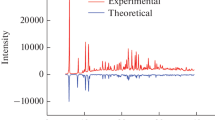Abstract
Two new palladium(II) complexes, dichloro-{bis(3,5-dimethylpyrazol-1-yl)acetic acid}palladium(II)PdCl2(3,5-Me2bpza)], (1) (3,5-Me2bpza = 3,5-dimethylpyrazol-1-yl)acetic acid) and dichloro-{bis(3,5-ditertbutylpyrazol-1-yl)acetic acid}palladium(II), [PdCl2(3,5-tBu2bpza)], (2a) [3,5-tBu2bpza = 3,5-ditertiarybutylpyrazol-1-yl)acetic acid] complexes, were synthesized from the reactions of pyrazol-1-yl ligands with palladium salts. Attempts to crystallize 2a led to a hydrolyzed product, dichloro-{3,5-ditertbutylpyrazol-1-yl}palladium(II) (2b), in which the acetic acid moiety in the ligand backbone of 1 is lost. Both complexes 1 and 2b have been characterized by single-crystal X-ray crystallography. Both complexes crystallized in triclinic system (P − 1 space group). The cell parameters are: complex 1 (a = 8.7960(14) Å, b = 16.238(2) Å, c = 16.430(2) Å, α = 78.038(10)°, β = 77.817(11)°, γ = 89.970(10)°) and complex 2b (a = 10.1492(2) Å, b = 12.4001(2) Å, c = 13.108(3) Å, α = 103.0690(10)°, β = 97.4120(10)°, γ = 107.2450(10)°). The asymmetric unit of 1 contains two crystallographic independent monomeric units of 1 and three molecules of DMSO solvent, whilst that of 2b has got one monomeric unit with one molecule of chloroform solvent.
Index Abstract
Two palladium complexes, dichloro-{bis(3,5-dimethylpyrazol-1-yl)acetic acid}palladium(II), PdCl2(3,5-Me2bpza)], (1) (3,5-Me2bpza = 3,5-dimethylpyrazol-1-yl)acetic acid) and dichloro-{bis(3,5-ditertbutylpyrazol-1-yl)acetic acid}palladium(II), [PdCl2(3,5-tBu2bpza)], (3,5-tBu2bpza = 3,5-ditertiarybutylpyrazol-1-yl)acetic acid) complexes, were synthesized from the reactions of pyrazol-1-yl ligands with palladium salts. Attempt to obtain crystals of tertiarybutylpyrazolyl analogue led to hydrolysis, the crystal structure of the hydrolysis product was established by single crystal X-ray crystallography.




Similar content being viewed by others
References
Reger DL, Brown KJ, Gardinier JR, Smith MD (2008) Organometallics 22:4973. doi:10.1021/om0305216
Burzlaff N, Hegelmann I, Weibert B (2001) J Organomet Chem 626:16. doi:10.1016/S0022-328X(01)00648-9
Beck A, Barth A, Hu¨bner E, Burzlaff N (2003) Inorg Chem 42:7182. doi:10.1021/ic034097c
Keter FK (2008) Ph.D. Thesis, University of Johannesburg
Drew D, Doyle JR (1972) Inorg Synth 13:47. doi:10.1002/9780470132449.ch11
Bruker (2005) APEX2. Version 2.0–1. Bruker AXS Inc., Madison
Bruker (2005) SAINT-NT. Version 6.0. (includes XPREP and SADABS). Bruker AXS Inc., Madison
Bruker (1999) SHELXTL. Version 5.1. (includes XS, XL, XP, XSHELL). Bruker AXS Inc., Madison
Spek AL (2003) J Appl Cryst 36:7. doi:10.1107/S0021889802022112
Farrugia LJ (1997) J Appl Cryst 30:565. doi:10.1107/S0021889897003117
Brandenburg K, Putz H (2005) Version 3.0c. Crystal Impact GbR, Bonn
Pettinari C, Pettinari R (2005) Coord Chem Rev 249:525 reference therein
Orpen AG, Brammer L, Allen FH, Kennard O, Watson DG, Taylor R (1989) J Chem Soc Dalton Trans S1. doi:10.1039/dt98900000s1
Allen FH (2002) Acta Crystallogr B 58:380. doi:10.1107/S0108768102003890
Acknowledgments
Financial supports for this work from the National Research Foundation (South Africa) and University of Johannesburg are gratefully acknowledged.
Author information
Authors and Affiliations
Corresponding author
Rights and permissions
About this article
Cite this article
Keter, F.K., Omondi, B. & Darkwa, J. Dichloro-{bis(Pyrazol-1-yl)}Palladium(II) Complexes: Structures of a DMSO Solvated Dichloro-{bis(3,5-Dimethylpyrazol-1-yl)Acetic Acid}Palladium(II) and Dichloro-{bis(3,5-Ditertbutylpyrazol-1-yl)Methane}Palladium(II). J Chem Crystallogr 39, 510–514 (2009). https://doi.org/10.1007/s10870-008-9513-9
Received:
Accepted:
Published:
Issue Date:
DOI: https://doi.org/10.1007/s10870-008-9513-9




